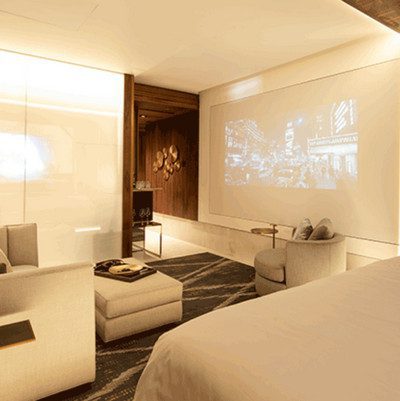Imagine you’re co-sponsoring an event for top designers who are vying to win Hilton’s “Ultimate Luxury Hotel Room” contest. The participants have 24 hours to develop a winning concept which will later be erected at the big Hospitality Design Expo (owned by CE Pro’s new parent company, Emerald Expo).
Designers can brainstorm and work with any of two-dozen vendors sponsoring the event, including design-centric staples like Kohler, PPG Pittsburgh Paints, Restoration Hardware and Serta.
There is a glass-door manufacturer on the vendor roster, as well as a fine-art purveyor, fabric supplier, tile manufacturer, and a popular provider of furniture and flourishes for the hospitality industry.
And then there’s you, a maker of high-end video projectors.
Who do you think is going to be the least popular kid at the design party?
“Initially, most people were not in a hurry to talk to me,” says Tim Sinnaeve of Barco Residential. “I didn’t have any cool fabrics or samples, and I didn’t look like part of this community.”
Speaking to integrators and vendors at the Azione Unlimited fall conference in Denver, Sinnaeve joked that when the designers finally stopped by the Barco stand, they seemed to do so under duress: “I’m doing it because I have to talk to all the vendors.”
A Necessary Evil
Such is the life of anyone involved in the luxury home-technology sector. The design community pays you a visit because they have to. What we do is often seen as a “necessary evil,” Sinnaeve says.
At some point during the 24-hour Hilton design frenzy, he pondered how to turn his own necessary evil – video projection – into a “design material,” he explains. “Think of this as a canvas, not a technology.”
Check out the winning room design
When the ultimate winner, Toronto-based Chapi Chapo Design, explained its concept of a 1920’s throwback design, Sinnaeve went to work grabbing images from the period and building a virtual canvas that could transport guests to the jazz age.
The visuals created an experience, which set the tone for a 1920’s space that resonated with the designers. And, by the way, the same technology used for visual backdrops could also be employed for work presentations and casual TV viewing.
The technology conversation, however, came at the end of the collaboration.
“Whatever you want to conceive, this is the tool to do it.” Sinnaeve told the designers. “It’s your vision. We have the technology and partners to do it.”
The winning project, heralded for its “modular” design, featured three projection systems, including integrations with smart boards and web cams for in-suite meetings and remote conferences.
ROE vs. ROI
Sinnaeve pointed to CE Pro research (“State of the Union,” January 2018) suggesting integrators are the primary product-selection influencers in nearly 47% of all projects. But while installers might dictate the products in a luxury install, they generally don’t influence the overall “experience,” which is largely defined by architects and interior designers.
Sinnaeve urges integrators to own the experience. A bunch of high-end video projection systems might not pay for themselves in terms of a home’s resale value, but who cares? What did the clients experience along the way? Was it worth it?
Forget ROI, he said at the conference. Start pitching ROE – return on experience – and put yourself in the position to sell that experience.

















